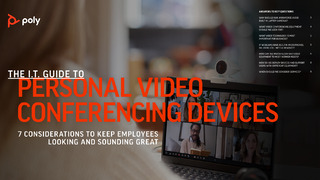The number of employees working from home and using video conferencing continues to grow, but they represent only one facet of the new reality for IT. Your workforce needs the right technology to work from anywhere, but laptops with standard built-in cameras and microphones don’t cut it for a professional video conferencing experience. Poor sound and image quality can disrupt critical sales, service, and internal team video calls, turn happy customers into frustrated complainers and make your remote workers feel second class.
Hats off to you for using what you had to keep everyone connected. But now it’s time to ensure your home, office, and hybrid workers look and sound their best, no matter where or how they work. To make this happen, you need solutions that elevate the individual experiences of your workers with professional-grade video and audio technology. Solutions that make home, office, and hybrid workers equal participants in critical conversations.
This guide outlines how to identify the right video conferencing equipment, features, and workstyle compatibility for every individual in your workforce. With these considerations in mind, you can ensure that your home, office, and hybrid workers are seen and heard with incredible clarity—consistently. Instead of just making do with default devices, you’ll be enabling them to make the most out of every video conference.

